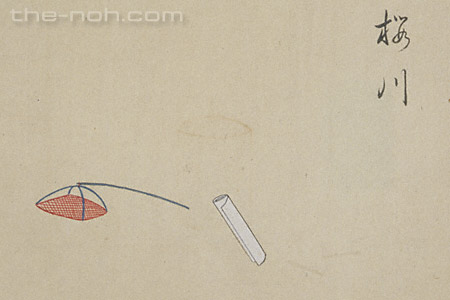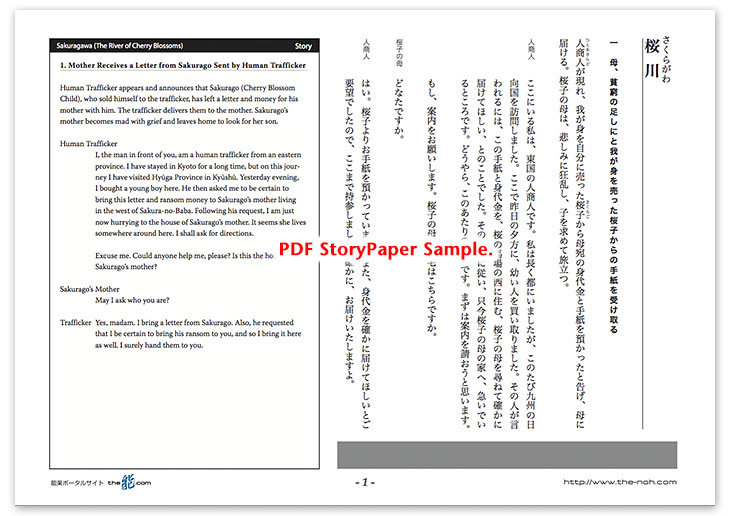
 Sakuragawa (The River of Cherry Blossoms)
Sakuragawa (The River of Cherry Blossoms)

![]()
In the Sakura-no-Baba (Cherry Blossom Riding Grounds) in the province of Hyūga (the present-day Miyazaki Prefecture), a mother and a son lived in poverty. The son, Sakurago (Cherry Blossom Child), distressed at his mother’s hardships, sold himself to a human trafficker. The mother learnt by a letter from the trafficker that her son sold himself. In a frenzy of grief and tears, she dashed out from her house and set out on a journey to find Sakurago.
Three years have passed since then. Sakurago has been apprenticed to a monk of Isobe-dera Temple in the remote province of Hitachi (the present-day Ibaraki Prefecture). The spring blossoms were at their peak, and the monk, with Sakurago and others, went out to Sakuragawa River, a nearby famous spot for cherry blossoms, to enjoy the view. Just then Sakurago’s mother arrives at the riverside of Sakuragawa after her long journey.
The mother, who became a madwoman, scoops cherry petals floating on the river with a net, showing her madness. When the monk asks her why she does this, she explains that she cannot waste the blossoms, related as they are to the name of her son, Sakurago, from whom she is separated. Enticed by the falling flowers, the mother reaches an extremity of frenzy, spurred on by her thoughts of her son.
Eventually the mother meets a boy accompanying the monk. Realizing that the boy is her son Sakurago, the mother regains her right mind, and sheds tears of joy—mother and child return home together. Later, the mother also renounces the world and obtains the blessings of the Buddha. Thus we are taught the lesson that the way of the parent and the child is truly precious.
![]()
This is one of the madwoman stories in which a mother, separated from her child, travels in her madness to look for that child. Although this piece has a happy ending, in which finally the child and mother meet, as it unfolds, the emotions of the son who pities his mother and of the mother who whole-heartedly loves her son are finely described and come to settle in the hearts of the audience.
Additionally, what deepens the savour of this piece is the variation in coloring based on cherry blossoms. According to the research of a scholar long ago, there are eleven kinds of cherry blossoms, forty-eight references to the word “cherry” (sakura in Japanese), and fifty-three references to flowers in this piece. The name of the separated son is “Sakurago (Cherry Blossom Child),” their hometown is “Sakura-no-Baba (Cherry Blossom Riding Grounds), and the setting for the climax of the story is at “Sakuragawa (The River of Cherry Blossoms).” In particular, the chorus, depicting the overlapping of the mother’s feelings and the river into which the cherry petals fall like snow, corresponds with the frantic dance of the mother; it describes the beautiful though fleeting, sad, poetic atmosphere of the drama. This is something to which only Noh drama can give expression. The special dance and chorus, from the kuse to Ami-no-dan (the Scene of the Net), is a must-see.
Since ancient times, cherry blossoms have been cherished by the Japanese. The audience can fully enjoy the deep emotions associated with this flower through the special techniques unique to the art of Noh.
Further, this piece, which chooses cherry blossoms as its subject, is often compared with “Mii-dera (Mii-dera Temple),” which is another madwoman story focusing on the moon. Your interest in Noh will be further deepened if you compare the two.
STORY PAPER : Sakuragawa (The River of Cherry Blossoms)
Story Paper presents noh chant stories in modern speech, with story outlines, highlights and more using Adobe PDF format, which can print out and zoom in. Print out the pages and take them with you when you see the actual noh performance.

The copyright of Story Paper is held by the Noh.com. Story Paper is for individual use only. It is prohibited by the copyright law to distribute or publish printed-out Story Paper pages without prior consent. For more information, check the credit and disclaimer pages.



 [Sakuragawa (The River of Cherry Blossoms) : Story Paper PDF : 507KB
[Sakuragawa (The River of Cherry Blossoms) : Story Paper PDF : 507KB